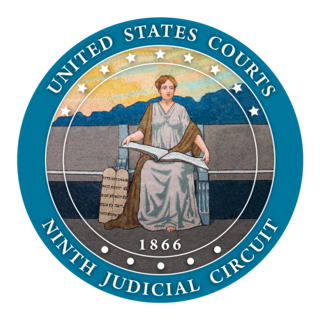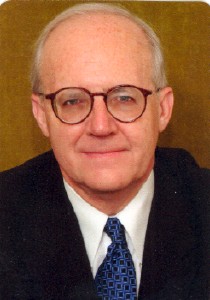Related Research Articles
Precedent is a principle or rule established in a legal case that becomes authoritative to a court or other tribunal when deciding subsequent cases with similar legal issues or facts. The legal doctrine stating that courts should follow precedent is called stare decisis.
In the United States, a state supreme court is the highest court in the state judiciary of a U.S. state. On matters of state law, the judgment of a state supreme court is considered final and binding in both state and federal courts.

The United States courts of appeals are the intermediate appellate courts of the United States federal judiciary. They hear appeals of cases from the United States district courts and some U.S. administrative agencies, and their decisions can be appealed to the Supreme Court of the United States. The courts of appeals are divided into 13 "Circuits". Eleven of the circuits are numbered "First" through "Eleventh" and cover geographic areas of the United States and hear appeals from the U.S. district courts within their borders. The District of Columbia Circuit covers only Washington, DC. The Federal Circuit hears appeals from federal courts across the entire United States in cases involving certain specialized areas of law.
In law, certiorari is a court process to seek judicial review of a decision of a lower court or government agency. Certiorari comes from the name of an English prerogative writ, issued by a superior court to direct that the record of the lower court be sent to the superior court for review. The term is Latin for "to be made more certain", and comes from the opening line of such writs, which traditionally began with the Latin words "Certiorari volumus...".

The United States Court of Appeals for the Ninth Circuit is the U.S. federal court of appeals that has appellate jurisdiction over the U.S. district courts in the following federal judicial districts:

Case citation is a system used by legal professionals to identify past court case decisions, either in series of books called reporters or law reports, or in a neutral style that identifies a decision regardless of where it is reported. Case citations are formatted differently in different jurisdictions, but generally contain the same key information.

The United States Court of Appeals for the Federal Circuit is one of the 13 United States courts of appeals. It has special appellate jurisdiction over certain categories of specialized cases in the U.S. federal court system. Specifically, it has exclusive appellate jurisdiction over all U.S. federal cases involving patents, trademark registrations, government contracts, veterans' benefits, public safety officers' benefits, federal employees' benefits, and various other types of cases. The Federal Circuit has no jurisdiction over criminal, bankruptcy, immigration, or U.S. state law cases. It is headquartered at the Howard T. Markey National Courts Building in Washington, DC.
The federal judiciary of the United States is one of the three branches of the federal government of the United States organized under the United States Constitution and laws of the federal government. The U.S. federal judiciary consists primarily of the U.S. Supreme Court, the U.S. Courts of Appeals, and the U.S. District Courts. It also includes a variety of other lesser federal tribunals.

Danny Julian Boggs is an American lawyer and a senior United States circuit judge of the United States Court of Appeals for the Sixth Circuit. He was appointed to the court in 1986 and served as its chief judge from September 2003 to August 2009. Boggs was on the short list of President George W. Bush's candidates for the U.S. Supreme Court.

The California Courts of Appeal are the state intermediate appellate courts in the U.S. state of California. The state is geographically divided along county lines into six appellate districts. The Courts of Appeal form the largest state-level intermediate appellate court system in the United States, with 106 justices.
Kenneth Francis Ripple is a Senior United States circuit judge of the United States Court of Appeals for the Seventh Circuit.

The Federal Appendix was a case law reporter published by West Publishing from 2001 to 2021. It collected judicial opinions of the United States courts of appeals that were not expressly selected or designated for publication. Such "unpublished" cases are ostensibly without value as precedent. However, the Supreme Court made a change to the Federal Rules of Appellate Procedure in 2006. Now, Rule 32.1 says that federal circuit courts are not allowed to prohibit the citation of unpublished opinions issued on or after January 1, 2007. Nevertheless, principles articulated in an opinion designated as "not for publication" are treated by the judges of that circuit as not necessarily binding on future panels hearing similar cases, nor on the district judges within the circuit.

The Federal Supplement is a case law reporter published by West Publishing in the United States that includes select opinions of the United States district courts since 1932, and is part of the National Reporter System. Although the Federal Supplement is an unofficial reporter and West is a private company that does not have a legal monopoly over the court opinions it publishes, it has so dominated the industry in the U.S. that legal professionals uniformly cite the Federal Supplement for included decisions. Approximately 40 new volumes are published per year.

The law of California consists of several levels, including constitutional, statutory, and regulatory law, as well as case law. The California Codes form the general statutory law, and most state agency regulations are available in the California Code of Regulations.

In United States federal courts, a circuit split, also known as a split of authority or split in authority, occurs when two or more different circuit courts of appeals provide conflicting rulings on the same legal issue. The existence of a circuit split is one of the factors that the Supreme Court of the United States considers when deciding whether to grant review of a case. Some scholars suggest that the Supreme Court is more likely to grant review of a case to resolve a circuit split than for any other reason.

Anastasoff v. United States, 223 F.3d 898, was a case decided by the U.S. Eighth Circuit on appeal from the U.S. District Court for the Eastern District of Missouri. It is notable for being the only case to consider the "Anastasoff issue", that is whether Article Three of the United States Constitution requires a federal court to treat unpublished opinions as precedent.

The law of the United States comprises many levels of codified and uncodified forms of law, of which the most important is the nation's Constitution, which prescribes the foundation of the federal government of the United States, as well as various civil liberties. The Constitution sets out the boundaries of federal law, which consists of Acts of Congress, treaties ratified by the Senate, regulations promulgated by the executive branch, and case law originating from the federal judiciary. The United States Code is the official compilation and codification of general and permanent federal statutory law.
In law, an appeal is the process in which cases are reviewed by a higher authority, where parties request a formal change to an official decision. Appeals function both as a process for error correction as well as a process of clarifying and interpreting law. Although appellate courts have existed for thousands of years, common law countries did not incorporate an affirmative right to appeal into their jurisprudence until the 19th century.

In some jurisdictions, a petition for review is a formal request for an appellate tribunal to review the decision of a lower court or administrative body. If a jurisdiction utilizes petitions for review, then parties seeking appellate review of their case may submit a formal petition for review to an appropriate court. In United States federal courts, the term "petition for review" is also used to describe petitions that seek review of federal agency actions.
References
- ↑ Martin, Boyce F. Jr. (1999), In Defense of Unpublished Opinions, vol. 60, Ohio St. L.J., p. 177
- ↑ Weaver, George M. (1987–1988), Precedential Value of Unpublished Judicial Opinions, The, vol. 39, Mercer L. Rev., p. 477
- ↑ Hannon, Michael (2001), Closer Look at Unpublished Opinions in the United States Courts of Appeals, A, vol. 3, J. App. Prac. & Process, p. 199
- ↑ Rempell, Scott (2016). "Unpublished Decisions and Precedent Shaping". SSRN 2785752.
- ↑ On Google books: , , and
- ↑ Aaron S. Bayer (August 24, 2009), Unpublished Appellate Opinions Are Still Commonplace, The National Law Journal
- ↑ "Archived copy" (PDF). Archived from the original (PDF) on 2011-09-30. Retrieved 2011-11-11.
{{cite web}}: CS1 maint: archived copy as title (link) - ↑ California Rules of Court, Rule 8.1125
- ↑ Arnold, Richard S. (1999), Unpublished Opinions: A Comment, vol. 1, J. App. Prac. & Process, p. 219
- ↑ Lauren K. Robel (Apr 1989), "The Myth of the Disposable Opinion: Unpublished Opinions and Government Litigants in the United States Courts of Appeals", Michigan Law Review, 87 (5): 940–962, doi:10.2307/1289226, JSTOR 1289226
- ↑ Leonidas Ralph Mecham, Admin. Office of the U.S. Courts, Judicial Business of United States Courts, Supplemental Table S-3, 2004 Annual Report of the Director Archived 2006-02-14 at the Wayback Machine , p. 39.
- ↑ Anastasoff v. United States , 223F.3d898 (8th Cir.2000).
- ↑ Hart v. Massanari,266F.3d1155(9th Cir.2001).
- ↑ Rule 32.1 Citing Judicial Dispositions, Federal Rules of Appellate Procedure
- ↑ Schiltz, Patrick J. (2005–2006), Citation of Unpublished Opinions in the Federal Courts of Appeals, vol. 74, Fordham L. Rev., p. 23
- ↑ Schiltz, Patrick J. (2005), Much Ado about Little: Explaining the Sturm und Drang over the Citation of Unpublished Opinions, vol. 62, Wash. & Lee L. Rev., p. 1429
- ↑ Shuldberg, Kirt (1997), Digital Influence: Technology and Unpublished Opinions in the Federal Courts of Appeals, vol. 85, Cal. L. Rev., p. 541
- ↑ Carpenter, Charles E. Jr. (1998–1999), No-Citation Rule for Unpublished Opinions: Do the Ends of Expediency for Overloaded Appellate Courts Justify the Means of Secrecy, The, vol. 50, S. C. L. Rev., p. 235
- ↑ Gardner, James N. (1975), Ninth Circuit's Unpublished Opinions: Denial of Equal Justice, vol. 61, A.B.A. J., p. 1224
- ↑ Fox, Lawrence J. (2003–2004), Those Unpublished Opinions: An Appropriate Expedience or an Abdication of Responsibility, vol. 32, Hofstra L. Rev., p. 1215
- ↑ Pearson, Martha Dragi (2003–2004), Citation of Unpublished Opinions as Precedent, vol. 55, Hastings L.J., p. 1235
- ↑ Songer, Donald (1990). "Criteria for Publication of Opinions in the U.S. Courts of Appeals". Judicature. 73: 307.
- ↑ Hannon, Michael (2001). "A Closer Look at Unpublished Opinions in the United States Courts of Appeals". J. Appellateice and Process. 3: 199.
- ↑ Brian P. Brooks (Spring 2002), Publishing Unpublished Opinions: A Review of the Federal Appendix, The Green Bag